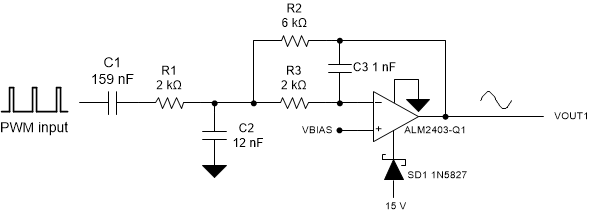ZHCSMT3A november 2020 – march 2023 ALM2403-Q1
PRODUCTION DATA
- 1 特性
- 2 应用
- 3 说明
- 4 Revision History
- 5 Pin Configuration and Functions
- 6 Specifications
- 7 Detailed Description
- 8 Application and Implementation
- 9 Device and Documentation Support
- 10Mechanical, Packaging, and Orderable Information
8.2.2.1 Resolver Excitation Amplifier Combined With MFB 2nd-Order, Low-Pass Filter
 Figure 8-3 Two-Pole MFB Filter
Figure 8-3 Two-Pole MFB FilterWhen designing a low-pass filter, the most important design criteria is to decide the corner frequency. In this design example, the resolver excitation frequency is 10 kHz and PWM frequency is 320 kHz. Thus, we want to make sure that the low-pass filter corner frequency is greater than 10 kHz, and there is maximum attenuation of harmonic interference generated from the PWM signal. Figure 8-3 shows a single channel of the ALM2403-Q1 configured as a 2-pole multiple feedback (MFB) filter with a –40 dB/decade rolloff. The MFB topology enables a steep rolloff while reducing BOM count. The output from this circuit is a sine wave that can then be inverted using the second channel of the ALM2403-Q1; see Figure 8-2. Thus, both ALM2403-Q1 channels combined provide the required resolver excitation signal.